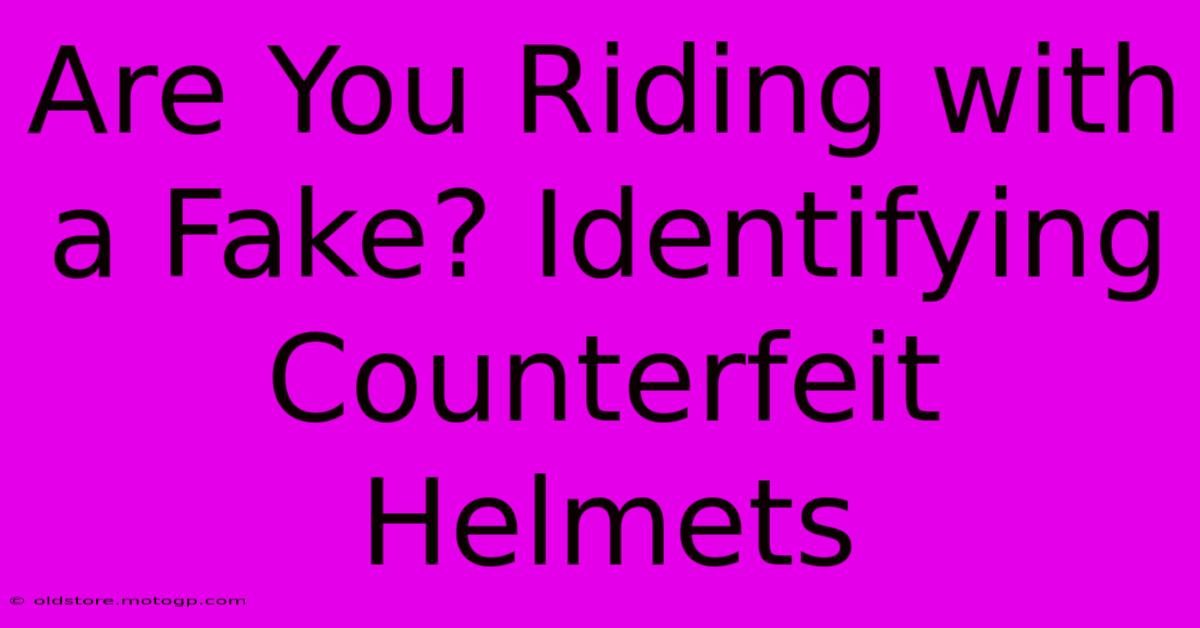Are You Riding With A Fake? Identifying Counterfeit Helmets

Table of Contents
Are You Riding with a Fake? Identifying Counterfeit Helmets
Motorcycle helmets are crucial for rider safety. A genuine helmet provides vital protection in a crash, but a counterfeit helmet? That's a different story entirely. Riding with a fake helmet puts your life at serious risk. This article will guide you on how to identify counterfeit motorcycle helmets and ensure you're always wearing genuine, reliable protection.
The Dangers of Counterfeit Helmets
Before we delve into identification, let's highlight the severe risks associated with counterfeit helmets:
- Compromised Safety: Fake helmets often fail to meet crucial safety standards. The materials used are inferior, and the construction is substandard, leading to significantly reduced impact protection. In a crash, a counterfeit helmet might shatter, offer minimal shock absorption, or even fail to stay on your head.
- Lack of Certification: Legitimate helmets display certification marks from organizations like DOT (Department of Transportation) in the US, ECE (Economic Commission for Europe) in Europe, or Snell Memorial Foundation. Counterfeits often mimic these markings, but they're fraudulent.
- Hidden Defects: Manufacturing flaws in counterfeit helmets are common and often hidden. These defects can compromise structural integrity, rendering the helmet useless in a collision.
- Legal Ramifications: In some jurisdictions, riding with an unapproved or counterfeit helmet can result in fines and legal penalties.
How to Spot a Fake Helmet
Identifying a counterfeit helmet requires careful inspection. Here's a checklist to help you:
1. Check for Certification Marks:
- Authenticity Verification: Look for the clearly visible and properly affixed certification marks. Check the manufacturer's website to learn how to verify the authenticity of the certification marks. Many manufacturers now offer QR codes or online verification systems.
- Placement & Clarity: The markings should be crisp and clear, not blurry or faded. Their placement should align with what's shown on the manufacturer's website.
- Consistency: The markings should be consistent on both the helmet and the packaging. Any inconsistencies are a major red flag.
2. Examine the Helmet's Construction:
- Material Quality: Genuine helmets use high-quality materials. Feel the shell; it should feel robust and solid, not flimsy or cheap. Examine the stitching; it should be neat and consistent. Poorly finished seams are a common sign of a counterfeit.
- Finish & Paint: The paint job on a genuine helmet is typically smooth and even. Look for imperfections, runs, or uneven color distribution—all potential indicators of a fake.
- Straps & Buckles: The chin strap should be securely fastened, using high-quality materials. The buckle should be easy to operate, but secure.
3. Investigate the Packaging and Documentation:
- Packaging Quality: The packaging should be professional and well-presented, matching the brand's usual standards. Poor quality printing, misspellings, or inconsistencies raise suspicion.
- Included Documentation: Genuine helmets usually come with instruction manuals, warranty information, and possibly a sticker for your vehicle. The absence of such documentation should trigger caution.
- Seller Reputation: Always buy from reputable dealers and retailers. Avoid suspiciously cheap prices or sellers with limited feedback.
4. Price Check:
- Unreasonably Low Prices: If a helmet's price is significantly lower than the market average for a similar model, it's a major warning sign. Genuine helmets don't come cheap.
Where to Buy Genuine Helmets
To minimize the risk of purchasing a fake, buy your helmet from:
- Authorized Dealers: Visit official brand websites to find authorized retailers in your area.
- Reputable Online Retailers: Stick to well-known online retailers with established return policies and customer reviews.
- Motorcycle Shops: Local motorcycle shops are excellent places to buy helmets. Their staff can advise you on choosing the right fit and ensure the helmet’s authenticity.
Remember: Your safety is paramount. Don't compromise on quality when it comes to motorcycle helmets. Taking the time to verify authenticity could save your life. Always prioritize safety over price.

Thank you for visiting our website wich cover about Are You Riding With A Fake? Identifying Counterfeit Helmets. We hope the information provided has been useful to you. Feel free to contact us if you have any questions or need further assistance. See you next time and dont miss to bookmark.
Featured Posts
-
Unleash Your Inner Racer Own A Moto Gp Legend
Feb 24, 2025
-
Unforgettable Experiences On The Queen Circuit
Feb 24, 2025
-
Moto Gp Photos The Beauty And Power Of Two Wheels
Feb 24, 2025
-
Conquer Cota Parking Lot R Hacks
Feb 24, 2025
-
Yamaha V4 Moto Gp Redefining Moto Gp
Feb 24, 2025
